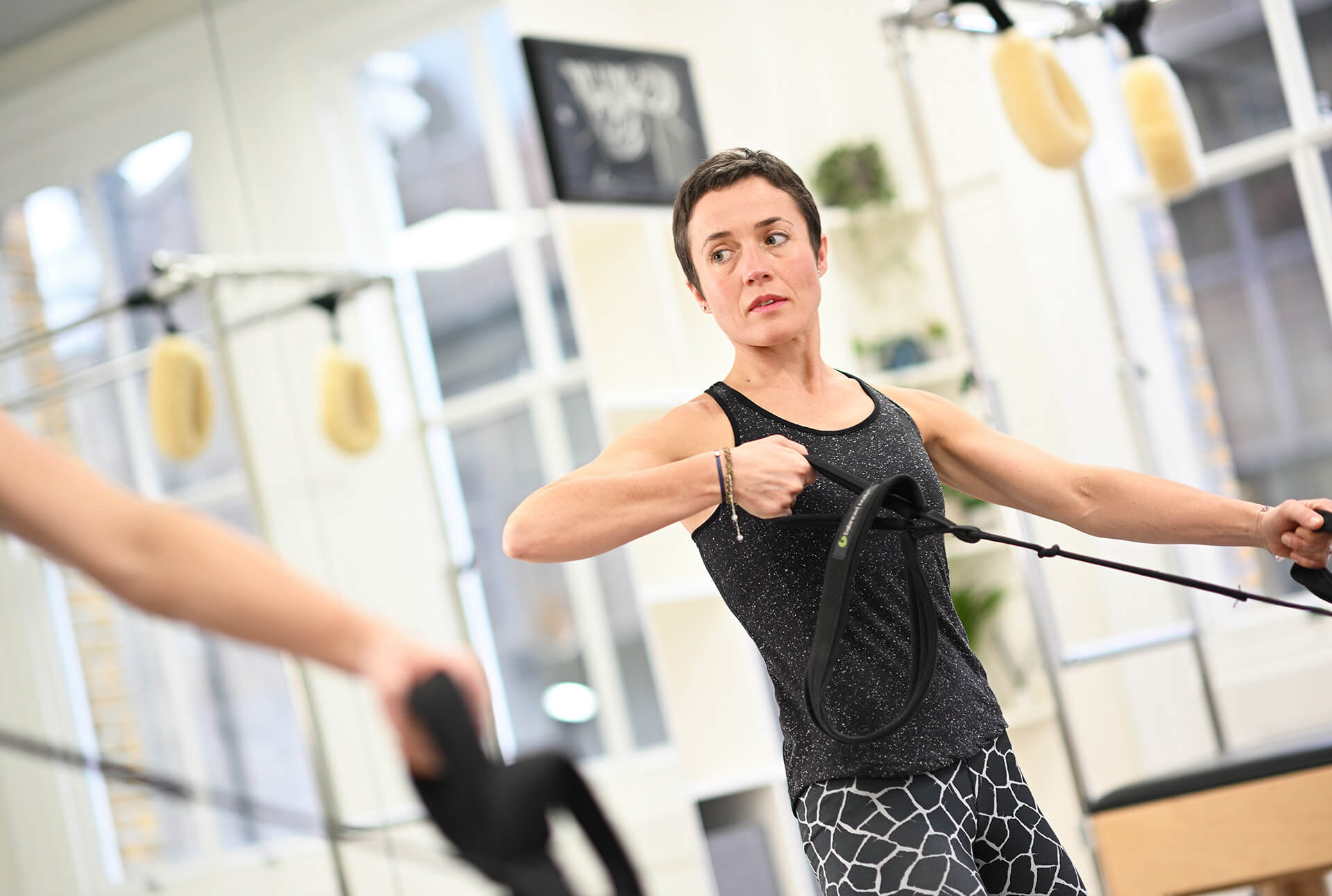Key Contributor: Melinda Yaman, Chartered Physiotherapist
Osteoarthritis is the most common form of arthritis in the UK and affects over 10 million people. We see a lot of patients in the Pilates studio who suffer with symptoms from osteoarthritis. But is Pilates good for Arthritis? This blog is about osteoarthritis and how Pilates can be beneficial.
What is osteoarthritis?
Osteoarthritis is a condition that causes the joints to become painful and stiff.
The severity and symptoms of arthritis can vary greatly from person to person and even between different joints in one person. People will most often report pain and stiffness in the joints, as well as swelling, clicking or creaking. These symptoms can lead to reduced function and quality of life as you become less able to do the things you enjoy without pain.
While any joint can be affected, the hips, knees, and small joints of the hands are frequently impacted.
Pilates for osteoarthritis
Pilates is a fantastic form of exercise for osteoarthritis as it is low impact, supportive and helps improve joint mobility as well as muscle strength. Another benefit of Pilates is that it doesn’t just focus on one area of the body, but ensures your whole body is working well. This holistic training promotes improvements in posture, balance, and overall bodily function, rather than solely targeting specific problem areas.
During 1-to-1 or small group clinical Pilates sessions, we tailor the program to your unique needs and goals. As everyone with osteoarthritis moves and feels differently, we assess each individual and provide personalised exercise, guidance and support, ensuring appropriate progression at the right pace.
Effective exercise programs should evolve over time to promote gradual improvements in strength, mobility and function. Pilates accommodates individuals of all fitness levels, from beginners to the most advanced movers, with modifications available to meet varying needs. Our studios have Pilates equipment such as reformers, trapeze tables and wunda chairs that help facilitate both assistance and resistance through movement, enhancing the effectiveness of the exercises beyond mat Pilates alone.
Pilates exercises for osteoarthritis
1. 90 / 90
Using the trapeze table, springs and supportive straps, we can elevate your legs into a supportive position where you can relax without the heavy effects of gravity. This promotes relaxation of the muscles and joints around your hips, knees and back. Your joints will feel offloaded and allow us to move your joints in a greater range than you may be able to when standing or under load.
2. Footwork
This is a very common and favourite starting point in our studios. It’s a great way to look at how we move during sit-to-stand and squatting movements, but you’re able to do it supported and lying down. We can change the resistance of the springs and the position of the foot bar to make it easier or more challenging, allowing us to load the knees and hips appropriately for you while you improve mobility and strength. Moving the joints safely helps stimulate lubrication of the joints which in turn helps reduce stiffness and discomfort.
3. Standing leg pump
This exercise is a great functional and weight bearing challenge. As you press down into resistance, you’ll be strengthening the muscles of your pelvis, hip and knee. The standing leg will be working hard to keep you balanced and your core and trunk will be working hard as stabilisers for your whole body. The resistance can be changed depending on your level.
Is Pilates good for arthritis in the knee?
Pilates offers a safe approach to alleviating symptoms and supporting healthy knees affected by arthritis. By enhancing body awareness, strengthening muscles, reducing pain, and correcting postural imbalances, it provides multifaceted benefits for those experiencing knee arthritis.
For those managing symptoms associated with arthritis, Pilates offers an alternative to traditional forms of exercise, with some research showing regular Pilates can be more effective than standard exercise at reducing pain in the knee.
Pilates can also play a preventative role for those who may be at risk of developing osteoarthritis of the knee by providing low-impact exercise to strengthen the muscles and supportive structures of the knee, and improving mechanics and loading patterns. Furthermore, for those who may have undergone a total knee replacement as a treatment for knee osteoarthritis, Pilates is a great rehabilitation tool post-operatively.
Is Pilates good for the joints?
Pilates is a great form of exercise for promoting joint health. Firstly, it aids in lubricating the joints by stimulating the production of synovial fluid, which prevents stiffness and maintains agility of the joint. Pilates movements promote the circulation of blood flow and nutrients to the joints, facilitating the delivery of oxygen and vital nutrients necessary for joint repair and the removal of damaged cells.
Moreover, it strengthens the muscles surrounding the joints to lessen pressure and load directly onto the joints. Pilates exercises also promote balance and coordination which help us move better and reduces risk of falls and injury.
Is Pilates good for arthritis of the spine?
Pilates is an excellent form of exercise to help those managing arthritis of the spine. The spine is divided into three parts; the cervical, thoracic and lumbar spine. All three areas can be affected by arthritis. The spine is made up of discs and vertebrae that are surrounded by spinal fluid. Pilates exercises that promote spinal mobility help to keep the spine lubricated.
Pilates exercises also promote strength of the spinal muscles which provide support to the spine and reduce the load that goes through the joints, improving symptoms of pain and stiffness. As with all Pilates equipment exercises, we can modify and adapt resistance levels and body positions to help you move most comfortably and effectively.
Treatment for osteoarthritis
Exercise should be top of the list for prevention and treatment of osteoarthritis. Although we cannot prevent osteoarthritis, we can ensure that the joints and muscles surrounding them are in good condition to withstand the forces that we put through them on a daily basis.
For those with osteoarthritis we know that the x-ray findings do not always correlate to symptoms. This means that without having to have surgery or change the joint surfaces we can potentially change the symptoms you are feeling. Exercise can help to change those symptoms.
Strengthening the muscles around a joint can help to reduce the load going through the joint surface. For example, in the knee we can change the symptoms by strengthening the quadriceps, hamstrings and calf.
Often people can be fearful of exercise as they are concerned it may make the symptoms worse. This can cause a negative spiral as when you do less, the muscles get weaker and the joints get stiffer which can lead to more pain and more fear.
Exercise is safe and beneficial in osteoarthritis and should be encouraged for all at the appropriate level.
Advice and education are key. The more you understand about your condition and how your joints respond to activity and loading the more you can manage your symptoms. Sometimes this may involve activity modification but keeping active and exercising is vital, so we like to find a way for you to be able to do this and stay active.
Other treatment may include;
- Weight loss advice
- Supportive footwear
- Pain killers
- Injections
- Joint replacement surgery
What do our experts say?
Pilates is an excellent form of exercise for people with osteoarthritis for several reasons. Firstly, it emphasises gentle, controlled movements which help to improve joint flexibility and range of motion without causing strain. It also strengthens the muscles surrounding the joints, providing better support, and reducing the load on areas affected by OA. Furthermore, Pilates encourages mindful movement which includes focused breathing and concentration, which can contribute to mental well-being by reducing stress. Overall, it is a wonderful system of exercise that not only addresses the physical symptoms of osteoarthritis but also enhances overall well-being and quality of life.
Frequently asked Questions:
Are osteoarthritis and arthritis the same thing?
Arthritis is a term that accounts for many conditions that cause inflammation of joints or connective tissue in the body.
Osteoarthritis is a specific form of arthritis that affects the cartilage of joints such as the spine, hips and knees. In healthy joints, cartilage covers the surface of bones to help them move freely. In osteoarthritis, the cartilage thins and becomes worn, which can lead to inflammation, pain and stiffness over time.
How do I know if I have osteoarthritis?
Osteoarthritis can be diagnosed using xray imaging of the joints. If you have joint pain and stiffness, your GP, physiotherapist or orthopaedic surgeon will examine your joints, discuss your history of symptoms and work towards a diagnosis.
Is reformer pilates good for arthritis?
The Pilates reformer is a versatile and effective piece of Pilates equipment. It’s design allows you to perform exercises in a variety of positions to facilitate a diverse range of exercises. It allows you to push, pull and resist static tension, and can be tailored for all levels of ability, mobility and strength.
For those with arthritis, it allows you to move your joints through their full range without impact or excessive loading of the joints. This means that you can build strength and mobility with reduced or no pain. Besides the local effects it has, it also allows those managing arthritis to have a positive movement experience and experience the other wonderful positive effects of exercise.
What about seniors with arthritis – can Pilates help?
As you age and continue to prioritise your health and wellbeing, you might look for more safe and effective ways to exercise. Pilates is a recommended form of exercise amongst healthcare professionals, particularly for older adults. It has been shown to enhance balance, function, cognition and mood, helping older adults with joint symptoms continue to live mobile and independent lives.
Come and visit one of our Pilates clinics.
If you would like any more advice and guidance around Pilates and arthritis ’, please do not hesitate to get in touch with us. Why not come and try a studio class of Pilates in Kensington or 1-2-1 session with Complete Pilates at any of our studios? You can also visit us at our Pilates studio on Fulham road or our Pilates studio in the City of London. If you have osteoarthritis and would like to know more or book a session then please do get in touch, we are here to help!
Education is key:
These blogs are designed to give information to everyone, however, it is important to remember that everyone is different! If you have not seen one of our therapists and have any questions about injuries, what you have read or whether this may be useful to you, please just ask. We are more than happy to help anyone and point you in the right direction. Our biggest belief is that education is key. The more you understand about your injury, illness and movement, the more you are likely to improve.




